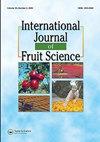Assessment of in Vitro Pollen Germination and Pollen Tube Growth of Annona Cherimola Mill
IF 2.5
3区 农林科学
Q2 HORTICULTURE
引用次数: 1
Abstract
ABSTRACT Yield in cherimoya (Annona cherimola Mill.) is affected by various factors reducing fertilization and fruit production such as: the protogynous dichogamy of the flowers, deficient natural pollination, and low pollen quality. The objective of this study was to determine in vitro the differences in pollen quality of nine ecotypes and one cultivar of A. cherimola from pollen samples collected at the female and male phenological stages of flowering. The percentage of pollen germination and the length of pollen tubes was evaluated in vitro at 2 and 24 hours after incubation at 21°C, in two phenological stages of the flowers during bloom in 2018 and 2019 seasons. The germination medium contained: 10% sucrose, 1% agar, 0.005% boric acid, and 0.025% calcium nitrate. Fabulosa and Austro ecotypes and the Fino de Jete cultivar had the highest pollen germination in the male phenological stage, after 2 and 24 hours in both seasons. Fabulosa had the highest percentage of germination in the female stage in both seasons. The ideal phenological stage for pollen collection was at anther dehiscence. Austro and Fabulosa ecotypes had the longest pollen tubes after 2 and 24 hours, in both phenological stages for both seasons. Fabulosa and Austro ecotypes, and Fino de Jete cultivar, showed promising pollen characteristics for hand pollination of cherimoya.番荔枝离体花粉萌发及花粉管生长的评价
摘要番荔枝(Annona cherimola Mill.)的产量受到多种因素的影响,如花的雌雄同体、自然授粉不足和花粉质量低等,降低了受精和果实产量。本研究旨在通过花期雌花和雄花物候期采集的花粉样品,在离体条件下测定9个生态型和1个凤仙花品种的花粉品质差异。在2018年和2019年花期的两个物候阶段,在21℃条件下培养2 h和24 h,对花粉发芽率和花粉管长度进行体外测定。萌发培养基为:10%蔗糖、1%琼脂、0.005%硼酸、0.025%硝酸钙。Fabulosa和Austro生态型以及Fino de Jete品种在两个季节的雄性物候期(2和24小时)花粉萌发率最高。在两个季节中,法布洛沙在雌期的发芽率最高。花粉收集的理想物候期是在花药开裂时。Austro生态型和Fabulosa生态型的花粉管在两个季节的两个物候阶段均在2 h和24 h时最长。Fabulosa和Austro生态型以及Fino de Jete品种具有较好的手传粉花粉特征。
本文章由计算机程序翻译,如有差异,请以英文原文为准。
求助全文
约1分钟内获得全文
求助全文
来源期刊

International Journal of Fruit Science
Agricultural and Biological Sciences-Agronomy and Crop Science
CiteScore
6.40
自引率
0.00%
发文量
64
审稿时长
10 weeks
期刊介绍:
The International Journal of Fruit Science disseminates results of current research that are immediately applicable to the grower, extension agent, and educator in a useful, legitimate, and scientific format. The focus of the journal is on new technologies and innovative approaches to the management and marketing of all types of fruits. It provides practical and fundamental information necessary for the superior growth and quality of fruit crops.
This journal examines fruit growing from a wide range of aspects, including:
-genetics and breeding
-pruning and training
-entomology, plant pathology, and weed science
-physiology and cultural practices
-marketing and economics
-fruit production, harvesting, and postharvest
 求助内容:
求助内容: 应助结果提醒方式:
应助结果提醒方式:


